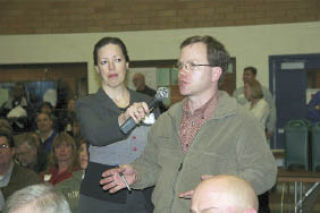Learning from the January flood was the business at hand last Wednesday, Feb. 11, at Tolt Middle School in Carnation, as hundreds of people from all parts of the Snoqualmie Valley gathered to talk about flood problems and solutions with the King County Council.
Residents, businesspeople and city officials gave their thoughts on ways that local flood response can be improved, and county councilmembers said they planned to listen and work to make the next flood less of a catastophe.
Nancy White of Fall City told the council that many of her neighbors still need big help.
“It’s been a month,” White said. “It looks like the flood happened yesterday.
Adam McCarty of Oxbow Farm was among residents who wanted free flood debris disposal started as soon as possible after the flood.
He made his biggest, nastiest trip to the dump before public disposal sites were set up.
“We can’t wait a week to dispose of our flood debris,” Lisa Eppley said.
Nela Cumming of Encompass asked the county to consider putting out flood alerts in other languages besides English.
County officials agreed that there is a need for that service. They have been talking to the Language Bank about ways to implement a multilingual alert.
Amara Oden, director of the Sno-Valley Senior Center, raised concerns about ensuring seniors are served during floods. Some older adults have medical needs that put them at risk when water, electricity and access are interrupted.
It’s a challenge “just knowing who the vulnerable people are, so they can do checks on them,” Oden said.
Train troubles
Northwest Railway Museum Executive Director Richard Anderson sought county support to change the Stafford Act, a federal law that limits how the museum gets flood relief. Currently, the museum will have to seek a $100,000 loan to fix its badly damaged tracks.
“We just want to be heard,” Anderson said.
The museum is still paying off a $50,000 loan for repairs after the 2006 flood. If the museum were to take the full loan amount this year, debt service could force the museum to cut jobs.
Lots to do
As a slideshow displayed images of the disaster — the swamped streets of Snoqualmie, closed highways near Fall City and Duvall, a mudslide in North Bend — King County Water and Land Services Director Mark Isaacson, Emergency Management Director Robin Friedman and Roads Services Director Debbie Arima talked about the county’s response.
Some flood preparation measures worked well, including efforts to raise homes in flood-prone areas and encourage farmers to create farm pads to put livestock and equipment above the water level. The county sent out warnings and patrols during the flood, and collected 800 tons of debris in the wake of the disaster.
Flood work that remains to be done in 2009 includes levee repairs and improvement projects totaling more than $3 million and home buyouts topping $6 million. Longterm fixes include removing hazardous river debris. The county foresees $50 million worth of work in the next five years.
With 500 levees, stretching across 119 miles, in need of maintenance, the county needs to prioritize its efforts, Isaacson said
“Where best can we apply our dollars?” he said.
The county has identified some flood response improvements, including creating a better warning system, and making sandbags more available.
• The Northwest Railway Museum is currently seeking donations from the public to offset flood damages. Donation information is available at the museum Web site, www.trainmuseum.org.



